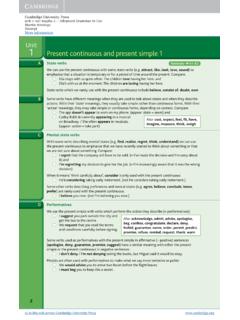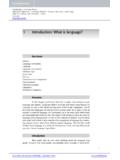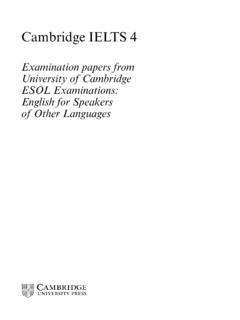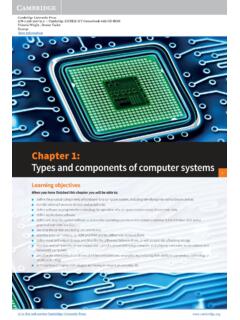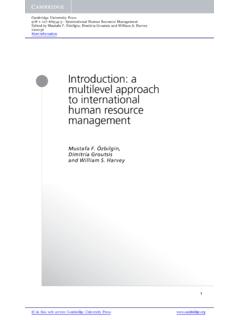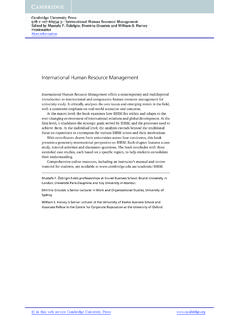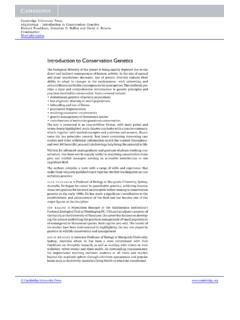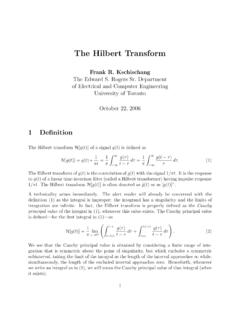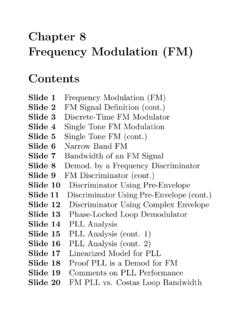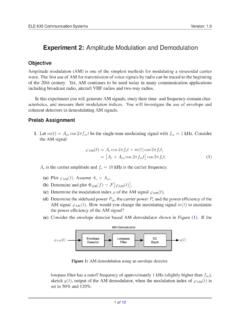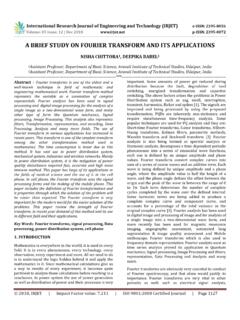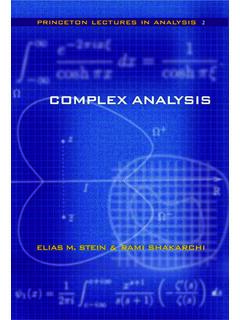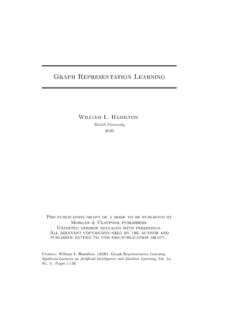Transcription of 1 Introduction to seismic data and processing
1 1 Introduction to seismic data and processingChapter seismic data and their acquisition, processing , and Sampled time series, sampling rate, and seismic amplitude and gain Phase and hilbert Data format and quality control (QC) SummaryFurther readingThe discipline of subsurface seismic imaging, or mapping the subsurface using seismicwaves, takes a remote sensing approach to probe the Earth s interior. It measuresground motion along the surface and in wellbores, then puts the recorded data througha series of data processing steps to produce seismic images of the Earth s interior interms of variations in seismic velocity and density. The ground movements recorded byseismic sensors (such as geophones and seismometers onshore, or hydrophones andocean bottom seismometers offshore) contain information on the media s response tothe seismic wave energy that traverses them. Hence the first topic of this chapter is onseismic data and their acquisition, processing , and interpretation processes.
2 Becausenearly all modern seismic data are in digital form in order to be stored and analyzedin computers, we need to learn several important concepts about sampled time seriessuch as sampling rate and aliasing; the latter is an artifact due to under-sampling. Inexploration seismology, many useful and quantifiable properties of seismic data arecalled seismic attributes. Two of the most common seismic attributes are the amplitudeand phase of seismic are introduced here togetherwith relevantprocessingissues such as gain control, phase properties of wavelets, and the hilbert transform ,Cambridge University Press978-0-521-19910-0 - Practical seismic Data AnalysisHua-Wei ZhouExcerptMore in this web service Cambridge University Press2 Practical seismic Data Analysiswhich enables many time-domain seismic attributes to be extracted. To process realseismic data, we also need to know the basic issues of data formats, the rules of storingseismic data in computers.
3 To assure that the data processing works, we need toconduct many quality control checks. These two topics are discussed together becausein practice some simple quality control measures need to be applied at the beginningstage of a processing newcomer to the field of seismic data processing needs to know the fundamentalprinciples as well as common technical terms in their new field. In this book, phrasesinboldfacedenote where special terms or concepts are defined or discussed. Tocomprehend each new term or concept, a reader should try to define the term in hisor her own words. The subject of seismic data processing often uses mathematicalformulas to quantify the physical concepts and logic behind the processing reader should try to learn the relevant mathematics as much as possible, and, atthe very least, try to understand the physical basis and potential applications for eachformula. Although it is impossible for this book to endorse particular seismic processingsoftware, readers are encouraged to use any commercially or openly accessible seismicprocessing software while learning seismic data processing procedures and advanced learner should try to write computer code for important processing stepsto allow an in-depth comprehension of the practical issues and data and their acquisition, processing , and a newcomer, you first want to know the big picture: the current and future objectivesand practices of seismic data processing , and the relationship of this field to other relateddisciplines.
4 You will need to comprehend the meanings of the most fundamental conceptsin this field. This section defines seismic data and a suite of related concepts such as signal-to-noise ratio (SNR or S/N), various seismic gathers, common midpoint (CMP) binningand fold, stacking, pre-stack versus post-stack data, and pre- processing versus advancedprocessing. The relationship between acquisition, processing , and interpretation of seismicdata is discussed here, since these three processes interrelate and complement each otherto constitute the discipline of subsurface seismic seismic dataSeismic dataare physical observations, measurements, or estimates about seismic sources, seismic waves, and their propagating media. They are components of the wider field ofgeophysical data, which includes information on seismic , magnetic, gravitational, geother-mal, electromagnetic, rock physics, tectonophysics, geodynamics, oceanography, and atmo-spheric sciences.
5 The form of seismic data varies, and can include analog graphs, digitaltime series, maps, text, or even ideas in some cases. This book treats the processing of asubset of seismic data, those in digital forms. We focus on the analysis of data on bodyCambridge University Press978-0-521-19910-0 - Practical seismic Data AnalysisHua-Wei ZhouExcerptMore in this web service Cambridge University Press3 Introduction to seismic data and processing AAccqquuiissiittiioonn PPrroocceessssiinngg IInntteerrpprreettaattiioonn DDaattaa QQCC IImmaaggiinngg MMooddeelliinngg Figure between data acquisition, processing , and , mostly P-waves, in their transmission, reflection, diffraction, refraction, and turningprocesses. The processing of other seismic data and many non- seismic data often followssimilar purpose of acquiring and processing seismic data is to learn something about theEarth s interior. To understand certain aspects of the Earth, we initially need to figureout some specific relations between the intended targets and measurable parameters.
6 Thenour first step is to conductdata acquisitiondesigned for the problem, our second stepto usedata processingto identify and enhance the desired signal, and our third step toconductdata interpretationsbased on the processed data. In reality, the processes of dataacquisition, processing and interpretation are interconnected and complement each other;their relationship may be viewed as shown in Figure data acquisition and before data processing , we need to conduct the process ofdataquality control,orQC. This involves checking the survey geometry, data format, andconsistency between different components of the dataset, and assuring ourselves that thequality and quantity of the dataset are satisfactory for our study objectives. The data QCprocess is typically part of thepre- processing . After pre- processing to suppress variouskinds of noise in the data, seismic imagingis conducted to produce various forms ofimagery for the interpretation process.
7 The seismic imaging methods include seismicmigration, seismic tomography, and many other methods of extracting various seismicattributes. Some people call seismic imaging methods the advanced processing . The scopeof this book covers the entire procedure from pre- processing to seismic data interpretation, we often conductseismic modelingusing the interpreted modeland the real data geometry to generate predictions to compare with the real measurements,and hence further verify the interpretation. The three inner arrows shown in Figure showhow the interactions between each pair of components (namely the data QC, imaging, ormodeling processes) are influenced by the third of seismic data gathersSeismic data acquisition in the energy industry employs a variety of acquisition cross-section views, Figure shows twoseismic acquisition spreads, the arrangementsof shots and receivers in seismic surveys. Panel (a) shows asplit spread, using a shotlocated in the middle and many receivers spread around it.
8 This spread is typical of onshoreCambridge University Press978-0-521-19910-0 - Practical seismic Data AnalysisHua-Wei ZhouExcerptMore in this web service Cambridge University Press4 Practical seismic Data Analysis(a) Split spread SR R R R R R R R R R R R R R R R R R R R R(b) End-on spreadSR R R R R R R R R R R R R R R R R R R R R RFigure views of two seismic data acquisition spreads and spreadOne CMP binSSSSSSSSS0 RnSn/2Rn/2 SnR1(a)(b)Figure views of (a) a common receiver gather and (b) a common midpoint(CMP) geometry using dynamite or Vibroseis technology as sources and geophones asreceivers. The real-world situation is much more complicated, with topographic variations,irregular source and receiver locations in 3D, and curving raypaths. Panel (b) shows anend-on spread, with a shot located at one end and all receivers located on one side ofthe shot.
9 This spread is the case for most offshore seismic surveys using airgun or othercontrolled sources near the boat and one or more streamers of hydrophones as comparison with onshore seismic data, offshore seismic data usually have much higherquality because of a number of favorable conditions offshore, including consistent andrepeatable sources, good coupling conditions at sources and receivers, and the uniformproperty of water as the medium. However, offshore seismic data may have particular noisesources, especially multiple reflections, and at present most 3D offshore seismic surveyshave much narrower azimuthal coverage than their onshore seismic data traces collected from many receivers that have recorded the same shot,such as that shown in Figure , produce acommon shot gather(CSG). Aseismic gatherrefers to a group of pre-stack seismic traces linked by a common threading point. The phrase pre-stack traces refers to data traces retaining the original source and receiver locations;they are in contrast to the post-stack or stacked traces that result from stacking orsumming many traces receiver gather(CRG) as shown in Figure is a collection of tracesrecorded by the same receiver from many shots, and acommon midpoint(CMP)gather(Figure ) is a collection of traces with their source-to-receiver midpoint falling withinthe same small area, called aCMP bin.
10 Among the three common types of seismic gathers,thereflection spread, or the lateral extent of reflection points from a seismic gather acrossa reflector, is zero for the CMP gather in the case of a flat reflector beneath a constantCambridge University Press978-0-521-19910-0 - Practical seismic Data AnalysisHua-Wei ZhouExcerptMore in this web service Cambridge University Press5 Introduction to seismic data and processing300040005000600070008000E-W (m)-1000-2000-3000-4000N-S (m)(a)InlinedirectionCrosslinedirectionI nlinedirectionCrosslinedirection-4000-20 000E-W offset (m)-2000200010000-1000-2000N-S offset (m)(b)Figure views of an acquisition geometry from the Canadian Rockies (Biondi, 2004).(a) Locations of shots (asterisks) and receivers (dots) for two consecutive shot gathers.(b) Offsets of 1000 traces, randomly medium (Figure ). There are other gathers, such as acommon image-point(CIG)gather, which is a collection of migrated traces at the same image bin people call a collection of traces with the same amount of source-to-receiver offsetas a common offset gather, though it is logically acommon offset binning and seismic illuminationOwing to the minimum spread of reflection points, traces of each CMP gather can besummed or stacked together to form a singlestacked trace, A stacked trace is oftenused to approximate a zero-offset trace, which can be acquired by placing a shot and areceiver at the same position.

